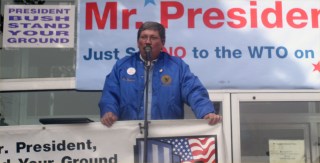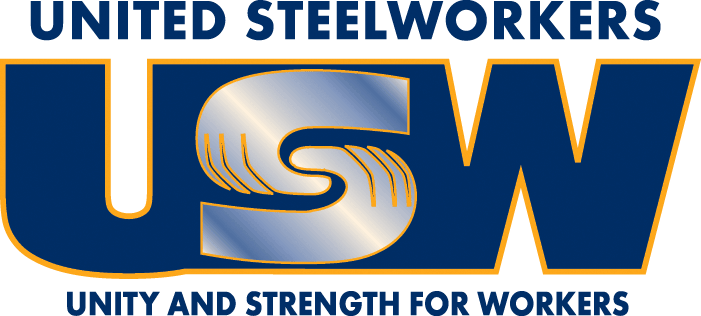JULY 15, 2009
50 YEAR ANNIVERSARY 0F THE 1959 STEEL STRIKE
The strike occurred over management's demand that the union give up a
contract clause which limited management's ability to change the number of
workers assigned to a task or to introduce new work rules or machinery which
would result in reduced hours or numbers of employees. The strike's effects
persuaded President Dwight D. Eisenhower to invoke the back-to-work
provisions of the Taft-Hartley Act. The union sued to have the Act declared
unconstitutional, but the Supreme Court upheld the law the union eventually
retained the contract clause and won minimal wage increases.
USWA founding President Philip Murray died in November 1952, and David J.
McDonald was named acting president by the USWA executive board. Although
observers felt that Murray had intended to push McDonald out of the union,
his sudden death left McDonald in a position to take control. In 1953, the
USWA executive board named McDonald president. [As president, McDonald
emphasized enhanced fringe benefits. The election of Dwight Eisenhower as
president and Republican majorities in the United States Congress (at least
from 1952 to 1954) made expansion of social programs unlikely. Subsequently,
McDonald focused negotiations on benefits such as unemployment compensation,
health insurance, pensions, tuition reimbursement and other items...
McDonald led the Steelworkers out on strike in 1956, winning substantial
wage increases, unemployment benefits, lay-off rights, and improved
pensions.
Prior to the 1959 strike, the major American steel companies were reporting
high profits. This led McDonald and Steelworkers general counsel Arthur J.
Goldberg to request a major wage increase. But industry negotiators refused
to grant a wage increase unless McDonald agreed to substantially alter or
eliminate Section 2(b) of the union's national master contract Section 2(b)
of the steelworkers' contract limited management's ability to change the
number of workers assigned to a task or to introduce new work rules or
machinery which would result in reduced hours or lower numbers of employees.
Management claimed that this constituted featherbedding and reduced the
competitiveness of the American steel industry McDonald characterized
management's proposals as an attempt to break the union. Negotiations broke
off, and the contract expired on July 1, 1959
President Eisenhower asked both sides to extend the agreement and resume
bargaining. McDonald and Goldberg offered to extend the contract by one
year. They also proposed creating a joint committee to study changes to
Section 2(b) and to the contract's benefit structure. Steelmakers rejected
the offer.
On July 15, 500,000 steelworkers went on strike. The strike shuttered nearly
every steel mill in the country. By the end of August, the Department of
Defense voiced concern that there would not be enough steel to meet national
defense needs in a crisis. The AFL-CIO quickly began to pressure McDonald to
end the strike. AFL-CIO president George Meany was willing to support the
strike, but not if it meant negatively affecting national security. The
strike was also affecting the auto making industry, which was threatening to
lay off tens of thousands of Walter Reuther's members due to a steel
shortage On September 28, 1959; Eisenhower met privately with McDonald and
Goldberg, and threatened to invoke the back-to-work provisions of the
Taft-Hartley Act. But McDonald was unwilling to budge on Section 2(b)
without other concessions from the steelmakers. The steel companies,
realizing they only needed to wait until Eisenhower forced union members
back to work, refused to make any such concessions
Eisenhower set in motion the Taft-Hartley machinery on October 7, and
appointed a Board of Inquiry. However, Eisenhower limited the Board's
mandate to clarifying the issues rather than recommending a settlement.
Realizing that the strike could linger despite the use of the Taft-Hartley
provisions, management offered a three-year contract with small improvements
in pay and fringe benefits and binding arbitration over Section 2(b).
McDonald rejected the offer. He proposed a contract similar to his proposal
of early July, but reduced the union's wage and benefits demand and limited
the contract to two rather than three years. Working from a plan devised by
Goldberg, McDonald also proposed a nine-member committee consisting of three
members from labor, management, and the public to study and resolve
work-rule issues. Management rejected the new proposal.
The Board of Inquiry issued its final report on October 19 and declared that
there was no chance of a negotiated settlement. On October 2, the Department
of Justice petitioned the federal district court for western Pennsylvania
for a Taft-Hartley injunction ordering the steelworkers back to work.
Goldberg argued that the Taft-Hartley Act was unconstitutional, but the
district court ruled for the government on October 21. However, the court
agreed to a stay of the injunction until the matter was fully settled. The
union appealed to the Third Circuit Court of Appeal in Philadelphia, and
lost again on October 27. The United States Supreme Court granted certiorari
and set argument for November 3, 1959
Meanwhile, a budding friendship between Goldberg and Kaiser Steel heir Edgar
Kaiser led to an independent settlement between the union and Kaiser Steel
on October 26. Although the Steelworkers won only a fractionally higher wage
increase than the steelmakers had proposed, the settlement included the
nine-member committee proposed earlier by Goldberg and McDonald.
On November 7, 1959, on the 116th day of the strike, the Supreme Court
upheld the appellate court's findings. In Steelworkers v. United States, 361
U.S. 39 (1959), in an 8-to-1 decision, the court upheld the
constitutionality of the Taft-Hartley Act. The justices affirmed the
district court's injunction ordering the workers back to work for an 80-day
cooling-off period. McDonald reluctantly ordered his members back to work,
but productivity slowed due to extremely poor relationships between workers
and managers. The Taft-Hartley Act required management to make a last offer
and for union members to vote on this proposal. Management proposed minimal
improvements in wages and benefits and the elimination of Section 2(b).
McDonald turned management of the union over to Goldberg, to concentrate the
legal and bargaining work in one set of hands. Goldberg convinced the
leadership of the union to reject the proposal, and the members followed
suit.
Nixon planned to run for president in 1960, and offered his services in the
hopes of negotiating a settlement which might win him labor's backing. The
Board of Inquiry, meanwhile, reconvened on November 10 and issued a second
report on January 6, 1960. The major issues, the Board said, remained the
size of the wage increase and Section 2(b).
In December, Nixon met privately with the steelmakers and cautioned them
that the Democratic Congress would soon begin hearings on the steel strike.
Neither Republicans nor Democrats would support the steel companies if the
strike triggered an election-year recession, and Nixon urged management to
accept the terms of the Kaiser Steel settlement. Industry executives agreed
to a new contract similar to the Kaiser Steel settlement the last week of
December.
On January 15, a new 20-month contract was signed. Section 2(b) was
preserved. Workers received a 7-cent an hour pay increase, 4.25 cents an
hour lower than the Kaiser Steel settlement and far lower than anything
McDonald had demanded. For the first time, however, the union won an
automatic cost-of-living wage adjustment as well as greatly improved pension
and health benefits. McDonald trumpeted the settlement as great victory
(given what might have happened).
A brief recession in 1962 led to layoffs, and when the economy recovered in
1963 and 1964 booming industry profits did not lead to wage increases. In
1965, I .W. Abel challenged McDonald for the presidency of the union. The
February 9, election was a bitter one. Voting irregularities and challenged
ballots delayed a final result until April 30. Abel won by a razor-thin
margin of 10,142 votes out of 600,678 cast.


![]()


